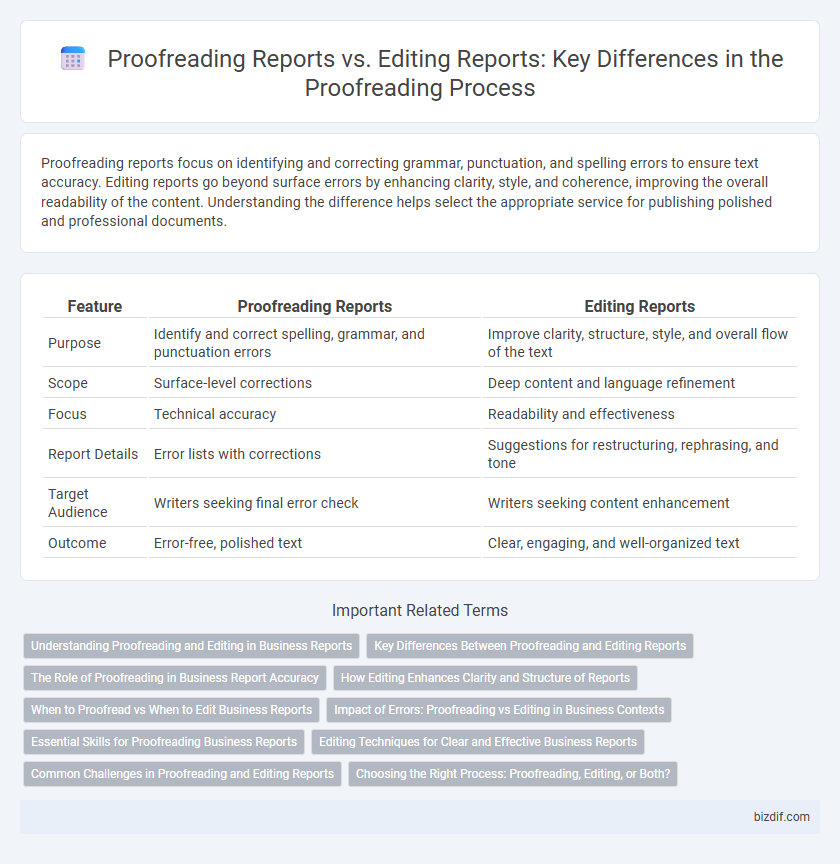Proofreading reports focus on identifying and correcting grammar, punctuation, and spelling errors to ensure text accuracy. Editing reports go beyond surface errors by enhancing clarity, style, and coherence, improving the overall readability of the content. Understanding the difference helps select the appropriate service for publishing polished and professional documents.
Table of Comparison
| Feature | Proofreading Reports | Editing Reports |
|---|---|---|
| Purpose | Identify and correct spelling, grammar, and punctuation errors | Improve clarity, structure, style, and overall flow of the text |
| Scope | Surface-level corrections | Deep content and language refinement |
| Focus | Technical accuracy | Readability and effectiveness |
| Report Details | Error lists with corrections | Suggestions for restructuring, rephrasing, and tone |
| Target Audience | Writers seeking final error check | Writers seeking content enhancement |
| Outcome | Error-free, polished text | Clear, engaging, and well-organized text |
Understanding Proofreading and Editing in Business Reports
Proofreading reports involves checking for grammatical errors, punctuation mistakes, and formatting inconsistencies to ensure clarity and professionalism in business documents. Editing reports goes deeper by improving sentence structure, enhancing tone, and clarifying meaning to align with the report's purpose and audience. Understanding the distinction between proofreading and editing is essential for delivering polished and effective business reports that communicate information accurately and persuasively.
Key Differences Between Proofreading and Editing Reports
Proofreading reports focus primarily on identifying and correcting surface-level errors such as typos, spelling mistakes, punctuation, and formatting inconsistencies. Editing reports, however, provide deeper analysis, addressing sentence structure, clarity, tone, and overall flow to improve readability and coherence. The key difference lies in proofreading's emphasis on accuracy and error correction, while editing enhances content quality and communication effectiveness.
The Role of Proofreading in Business Report Accuracy
Proofreading plays a crucial role in enhancing business report accuracy by meticulously identifying and correcting typographical, grammatical, and formatting errors that could undermine the report's credibility. Unlike editing reports, which focus on content clarity and structure, proofreading reports ensure the final document is polished and error-free, maintaining professional standards. This precision helps businesses convey clear, reliable information, supporting effective decision-making and stakeholder confidence.
How Editing Enhances Clarity and Structure of Reports
Editing enhances the clarity and structure of reports by refining sentence flow, ensuring logical organization, and eliminating ambiguity. Unlike proofreading, which primarily catches surface-level errors, editing restructures content to improve readability and coherence, making complex ideas more accessible. This process strengthens argument development and consistency, ultimately producing a polished and professional report.
When to Proofread vs When to Edit Business Reports
Proofreading reports is essential when finalizing business documents to catch typographical, grammatical, and formatting errors that could undermine professionalism. Editing reports is necessary during earlier drafting stages to improve clarity, coherence, and overall content structure, ensuring the message aligns with business objectives. Businesses should choose proofreading for polished, error-free presentations and editing when significant revisions or content enhancements are required.
Impact of Errors: Proofreading vs Editing in Business Contexts
Proofreading reports primarily identify surface-level errors such as typos, grammatical mistakes, and formatting inconsistencies, ensuring clarity and professionalism in business documents. Editing reports go deeper by enhancing content structure, tone, and overall coherence, which directly impacts the effectiveness of communication and decision-making in corporate environments. Inaccurate proofreading can undermine brand credibility, while insufficient editing may result in misinterpretation, affecting stakeholder trust and business outcomes.
Essential Skills for Proofreading Business Reports
Mastering essential skills such as attention to detail, grammar accuracy, and consistent formatting is critical for effective proofreading of business reports. Proofreading reports ensures that the final document is free from typographical errors, punctuation mistakes, and layout inconsistencies, enhancing its professional presentation. Unlike editing reports, which involve content restructuring and clarity improvements, proofreading focuses primarily on surface-level corrections to maintain the report's integrity and readability.
Editing Techniques for Clear and Effective Business Reports
Editing techniques for clear and effective business reports emphasize improving clarity, conciseness, and coherence by reorganizing content, refining sentence structure, and enhancing word choice to match the target audience. Unlike proofreading reports that primarily focus on correcting grammar, punctuation, and typographical errors, editing reports involve substantive revisions that elevate the overall quality and professionalism of the document. Incorporating targeted editing strategies ensures business reports convey key messages persuasively and facilitate informed decision-making.
Common Challenges in Proofreading and Editing Reports
Proofreading reports often face challenges such as identifying subtle typographical errors, grammatical inconsistencies, and formatting issues that require meticulous attention to detail. Editing reports involve more complex difficulties, including maintaining the author's original voice while improving clarity, coherence, and style. Both processes demand a deep understanding of language rules and the document's purpose to ensure accuracy and readability.
Choosing the Right Process: Proofreading, Editing, or Both?
Choosing the right process between proofreading and editing depends on the document's needs and the desired level of refinement. Proofreading reports focus on identifying and correcting surface errors such as grammar, punctuation, and spelling, while editing reports address deeper issues like clarity, structure, and tone. For comprehensive quality assurance, combining both proofreading and editing often yields the most polished and professional results.
Proofreading Reports vs Editing Reports Infographic

 bizdif.com
bizdif.com